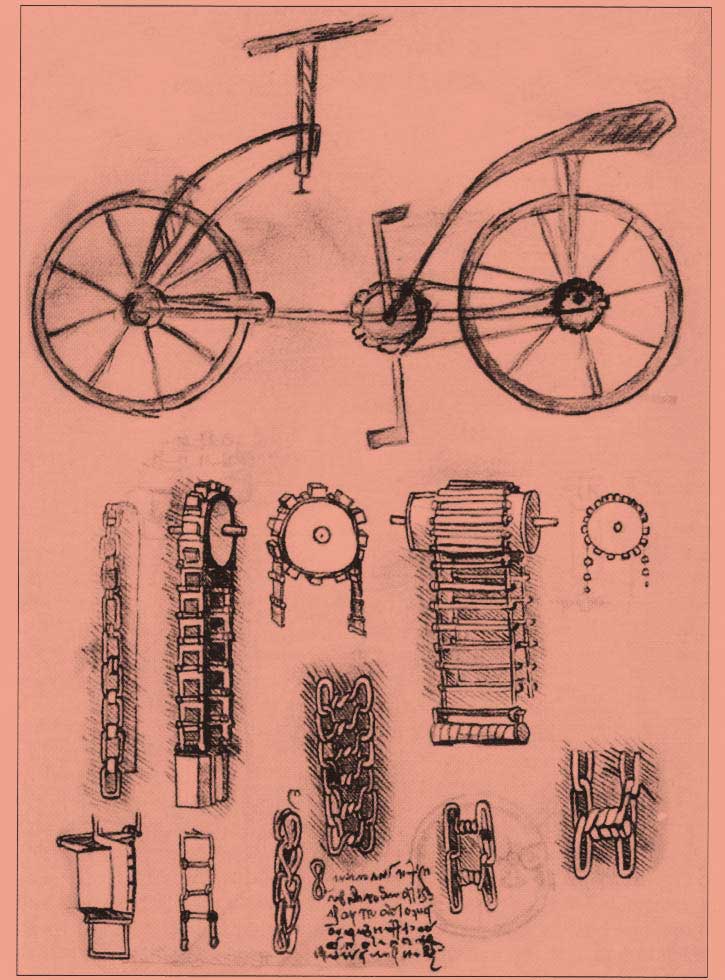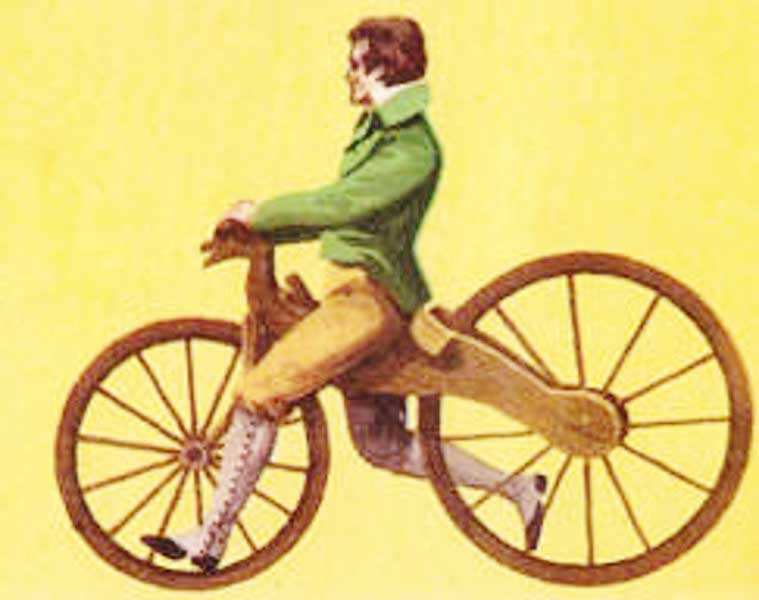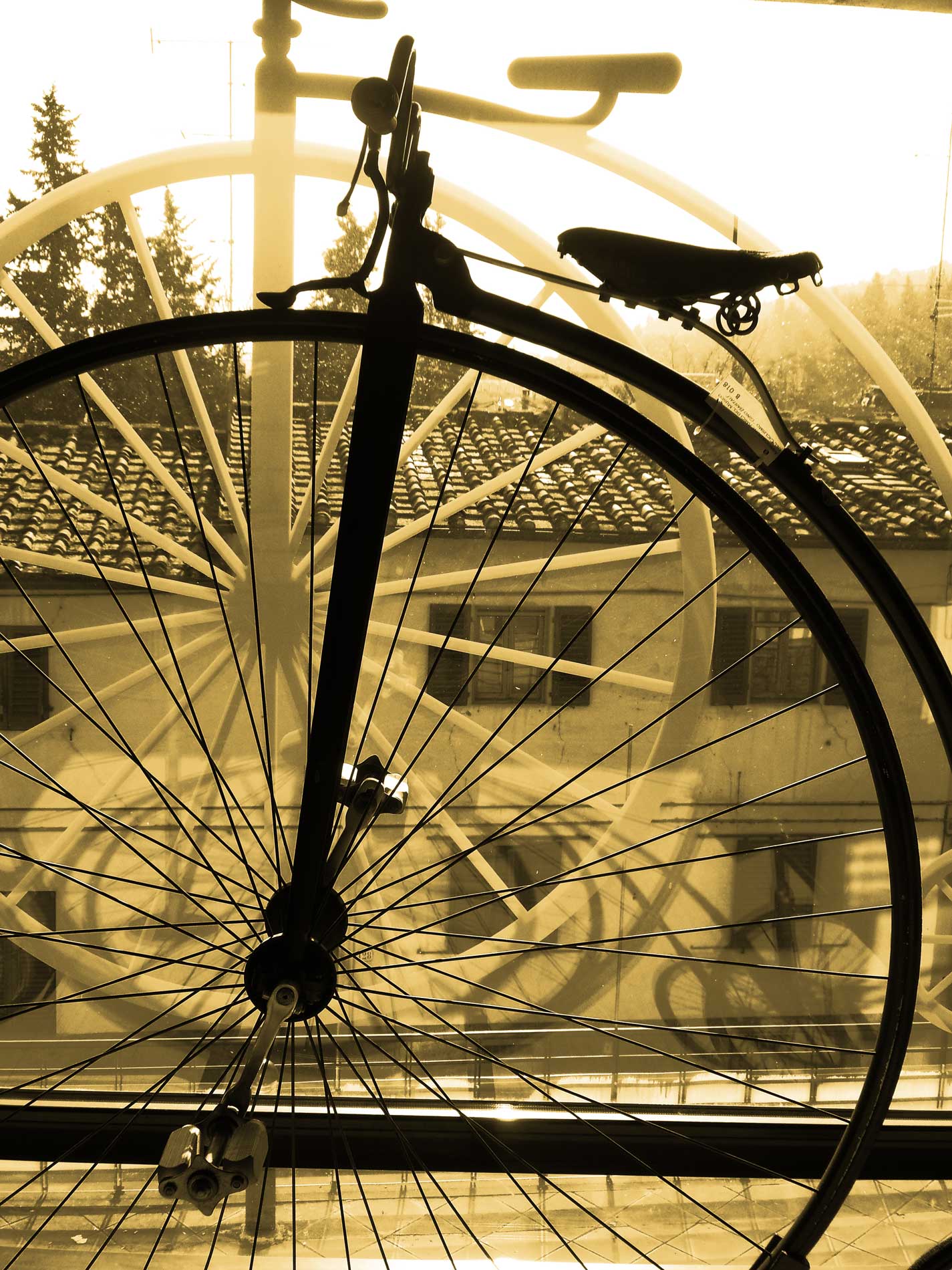A date has been established for the birth of the bicycle: 12th June 1817. In reality projects have been found on a transportation means similar to the bicycle in the Atlantic Code (1480 – 1510), merit of Leonardo da Vinci. The indefaticable mind of this Tuscan genius, who treated about architecture, anatomy, engineering, sculpture, scenography and a lot more, drew a rudimentary bicycle: two wheels of the same dimension, a sort of handlebar rudder and a chain transmission actioned by a pedal crank mechanism.
We suppose that this “machine”, drawing proposed on the cover of my article, had been planned as an application to the flying machines to which Leonardo devoted his studies. Maybe for this with time totally neglected and disconnected from the idea of the bicycle, thought of instead as a means of transport.
The date 12 th June 1817 coincides with the origin of the “draisina”,
ideated by the German Baron Karl Drais von Sauerbronn, who inspired the “celerifero” of the Count Mède De Sivrac. A means composed of wood and elements in iron, constituted by an essential frame with fixed wheels and without any bicycle pedal. It was 1791. The draisina had something more: a handlebar on the front wheel, that made the means “efficient” and therefore more interesting. Only in 1855 Pierre Michaux applied to the draisina a pedal on the front wheel. Michaux’s son improved the means by applying two identical pedals, in this way it was not necessary any more to give the bicycle a thrush from the ground to move it.
Guilmet and Meyer in 1867 remembered the “forgotten”model by Leonardo da Vinci,
giving a chain transmission to the bicycle. Before its diffusion in Italy, the bicycle was diffused in France, England and Germany. And it took time to comprehend the geniality of the invention. It is sufficient to think that the idea of Leonardo Da Vinci remained waiting for ages. During the time of Florence, capital of Italy, the bicycle was a novelty of amusement for all the social classes but principally for the noble.
The first florentine cycling club iniciates in 1869, “the Veloce Club”.
The association dedicated itself in the organization of the first agonistic races, dedicated to participants of other nations: the Florence – Pistoia. 2 h and 12 minutes the first classified. At the same time the bicycle of James Starley diffused itself with the bigger front wheel, that promised to reach major speed also even if difficult to move for the hight of the means.
In 1889 John Boyd Dunlop obtained the patent for the invention of the bicycle tyre.
The birth of the bicycle, initially conceived as an entertainment in the free time, put a great interest in the agonistic genre. The races intensified themselves from 1890 with the construction of cycle racing tracks. In 1896 the bike was given an electric lamp with dinamo. They were the years of the first regulable saddles, of the first experimental gear.
The fashion of this bike seemed to have a moment of crisis among the years of the Eighteenth century and the beginning of the new century.
The nineteenth century uncertainty in the whole of Europe, for the political-economic and social level. 1909 was the year of the first Italian Tour, recently celebrated for its centenary (they did not race during the war). The phenomenon of the “Giro d’Italia” increased the sales of bikes and the two wheels started to be more known through the press. It was for an agonistic and sportive reason that the bike became famous. In the twenties the brakes and a first sort of bicycle shifter were introduced. Initially you had to get down from the bike and take off the wheel taking the chain to the bigger pinion. The whole took a long time.
“The Vittoria Margherita” was the gear system with which my grandfather Gino started to run.
You had to move a side levar to increase or decrease the levar tension of the chain. It was complex but a great innovation. Apart from the “Giro d’Italia” they continued to dispute tours for the whole year. Races that lasted every 14 hours. The heroic cycling was not an unusual name. They ran laps of an average of 300 km, some consisted of a journey of more than 400 km. They left in the night and arrived in the afternoon of the following day. Heroic exploits on beaten earth roads, without radio communication, without bicycle of rechange. The longer lap of the Italian Tour was the Lucca-Rome 430 km, it was the 28th May 1914. The year when my grandfather Gino was born.
Another shifter used by Bartali was the Campagnolo Corsa, evolution of the Vittoria Margherita, but more complex to use. Through two levers fixed on the frame, with one you had to slacken the chain while with the other you moved the chain. All of which without descending from the bike, doing a manual work and at the same time looking behind.
The birth of the bicycle is not to be attributed to 200 years ago,
but it was in the Eighteenth century that it was born continuing till today to evolve. The bike had always had difficulties in affirming itself and cars have damaged the diffusion, but I believe profoundly in this means at the present time and for our future. That it can be used in daily life and that it can be our exercise in the weekends and that it can be agonism.
Translated from the Italian by Eleonora Spada o.c.d.s.
Questa pagina è disponibile anche in: Italiano



